WHAT'S NEW
ACROSS THE WORLD
Select date in side bar to go to a What's
New of previous issues
| What's New ©by
Laif DeMason
Hot enough for you today? A question considered by many of us this summer! A good excuse to go inside and work in the fish room. Indeed, I hope most of you survived the summer’s extreme weather from excess heat to torrential rains and flooding. Even the American Cichlid Association’s convention this year in Milwaukee did not escape from the adverse weather. On Thursday of the meeting, we were hit by 5”+ torrential rains and a tornado warning, flooding the airport and interrupting the convention. Several of the speakers’ and attendees’ flights, not to mention show fish shipped, were diverted from Milwaukee and arrived the next day by other means. Hotel guests were made to huddle on the ground floor after the tornado sirens sounded in the town until the danger had passed. Fortunately, the convention still came together and went off as planned. An extreme cichlid time was had by all! On an ACA side note: congratulations to Dr. Wayne Leibel who was awarded an ACA Guy D. Jordan Retrospective Fellow award this year for his life time contributions to the cichlid hobby, one of the few to receive this high distinction!
Here’s “what’s new” on the cichlid
scene:
|
Lake Malawi
Collectors and exporters of wild material have readjusted their efforts according to the low demand for these items. The lack of interest could be due to the increased costs associated with the shipping of these items from Malawi. Still, some material is being shipped in low numbers. New Malawi items have been appearing from breeders in the Far East and could be distracting Malawi hobbyists of late. We have been seeing different strange OB patterned Malawi fishes and unusual albino forms. Is this the new direction for Malawi cichlids in the future; new bred "morphs" from the Far East?

Incidental cichlids from Malawi are still sought after by avid collectors, if they only could be had. This Rhamphochromis longiceps would fit the bill only if it could be collected all year round on demand...!
|

Reportedly produced in the Far East, is an albino form of Labidochromis caeruleus yellow with red eyes. I am not really sure if this new variety will be different enough from the original strain to make a mark.
|
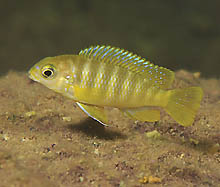
Collected in Mbamba Bay, Tanzania, Tropheops sp. 'higga' is one of several types of mbuna hobbyists are taking a fresh look at. Females are yellow in color and thus the offspring will be the same color. Photo by A. Konings.
|
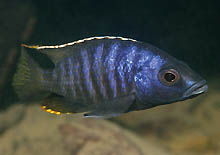
Incidentally collected from different parts of the lake, but recently exported from Tanzania, Otopharnyx spelaeotes is often sold as King Cave. Don’t wait to buy them next time; they may not be shipped again until next year! Photo by A. Konings.
|
Lake Tanganyika
Interest in the cichlids from Tanganyika remains strong. Hobbyists are trying their hands at keeping and breeding several varieties including goby cichlids, shell dwellers, featherfins, Petrochromis, Cyprichromis, and Tropheus species. In response, collectors and exporters have increased efforts to offer some of these items from the normal nearby collecting sites. Exporters also have been finding new items to sell from greater depths than normally harvested. These rarely seen "deeper" fishes have been trickling out a few at a time.
|
what's
new: Lake Tanganyika
|

Exported from Zambia without collecting location (only the southwestern part of the lake) and sold as Cyprichromis leptosoma blue orchid, this fish is another jumbo type of C. leptosoma. |

Reportedly originally from Tanzania, this Telmatochromis dhonti has orange highlights on the unpaired fins, eye ring, and behind the operculum. This species is one of the bulldog types of Telmatochromis, as is easily seen. |

Exported a few times from Zambia a few years ago Bathybates minor arrived in small numbers and was never shipped again. Fortunately a few hobbyists snatched them up and have been successful in reproducing them. |

Rarely imported in the past but now actively sought by hobbyists willing to pay high dollars to have this deep denizen from Bulu Point, Tanzania, Petrochromis sp. 'red' has been exported again. Until lately, the last time this fish was exported was almost 18 years ago. |
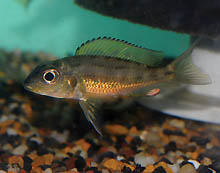
First exported in the early 1990s from the Congo coast, this Callochromis macrops sports a large orange area in the ventral part of their body. This fish has recently arrived again in low numbers, but is now offered as captive-bred juveniles which color up at a young age and sold as Orange Melanostigma. |
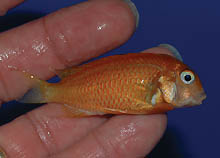
This aquarium morph produced in Burundi from a Tropheus sp. Karambe has a pink colored body similar to an albino form but lacks red eyes. With the strong red coloration suffused throughout the body, this rare strain is called Red Bishop and should be a hit with Tropheus fans. |
West Africa
Several shippers in West Africa have sold less in Europe and the United States over the last year. However, direct shipments to the Far East seem to keep these exporters afloat. Increased local costs in West African countries have continued to eat at profits for fish sellers, thus making the business less interesting. Further, West African cichlid hobbyists and Far East breeders continue to breed more exotic items and trade among themselves, making some of the standard wild items less profitable to sell.

One of the riverine lamprologines collected from near Kinshasa, Congo, but sold now with its correct scientific name: Lamprologus werneri. This interesting cichlid has bright neon spangles throughout the posterior body and is sometimes sent mixed with other, similar species. |

This endemic cichlid species is from Lake Barombi Mbo, Cameroon, and is one of the several Stomotepia species found only there. Stomotepia mongo has a bit more color than the other species imported to date and has an interesting torpedo-shaped body. |
Neotropics
More interest in cichlids from the Americas is evident. Countries in southern areas of South America are being investigated and collected for and by aquarists lately, bringing special attention to those newly found fishes. Further, several new aquarium strains of known species have also made their marks.

Exported recently from Colombia and sold as Crenicichla sp. 'Orinoco', this fish sports network-like black body lines and red fins. It is also know by the name Crenicichla sp. 'Atabapo' one of at least two different pike cichlids found there. |

Certainly one of the more impressive color morphs produced to date, the Electric Blue Ram. Reportedly produced by breeders in the Far East, this remarkable little fish is a sure hit with dwarf cichlid fans and other cichlid keepers. |
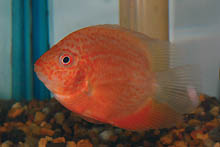
A differently colored cichlid offered in the past, but available again is the "Red Streak Severum". Not found in the wild, this fish was reportedly produced in the Far East by breeders there.
|
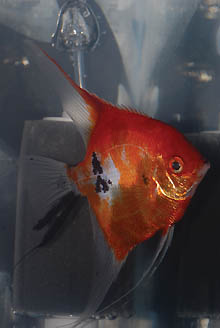
One of the newer strains of angel fish, Pterophyllum scalare, is the koi angel. The amount of orange-red color depends both on its genetics and the amount of carotene pigments in its diet.
|
Select date in side bar to go a What's
New of previous issues
|















